#PDE solver
Explore tagged Tumblr posts
Text
Best Programming Language to Solve the Reynolds Equation for Lubrication Simulations
The Reynolds equation is fundamental in fluid film lubrication analysis, often solved using numerical methods like finite difference or finite element approaches. Whether you’re a researcher, engineer, or student, choosing the right programming language can dramatically impact your development speed, simulation performance, and visualization capabilities. 🔍 What is the Reynolds Equation? The…
#bearing simulation#computational mechanics#engineering software#finite difference method#finite element method#fluid film lubrication#high performance computing#Julia for engineers#Julia programming#Julia vs MATLAB#lubrication simulation#matlab#numerical simulation#open source simulation#PDE solver#Python for engineering#Reynolds equation#Reynolds solver#scientific computing#tribology
0 notes
Text
Technique could efficiently solve partial differential equations for numerous applications | MIT News
In fields such as physics and engineering, partial differential equations (PDEs) are used to model complex physical processes to generate insight into how some of the most complicated physical and natural systems in the world function. To solve these difficult equations, researchers use high-fidelity numerical solvers, which can be very time-consuming and computationally expensive to run. The…

View On WordPress
3 notes
·
View notes
Text
ColibriTD Launches QUICK-PDE Hybrid Solver On IBM Qiskit

ColibriTD
The IBM Qiskit Functions Catalogue now includes ColibriTD's quantum-classical hybrid partial differential equation (PDE) solution QUICK-PDE. Based on IBM's H-DES (Hybrid Differential Equation Solver) technique, QUICK-PDE lets researchers and developers solve domain-specific multiphysics PDEs via cloud access to utility-scale quantum devices.
QUICK-PDE
QUICK-PDE was developed by quantum-powered multiphysics simulation company ColibriTD. IBM Qiskit Functions Catalogue lists it as an application function. QUICK-PDE is part of ColibriTD's QUICK platform.
The function lets researchers, developers, and simulation engineers solve multiphysics partial differential equations using IBM quantum computers in the cloud. For domain-specific partial differential equation solutions, it simplifies and makes development easier.
It works
ColibriTD's unique H-DES algorithm underpins QUICK-PDE. To solve differential equations, trial solutions are encoded as linear combinations of orthogonal functions, commonly Chebyshev polynomials. The function is encoded using $2^n$ Chebyshev polynomials, where $n$ is the number of qubits.
Variable Quantum Circuit (VQC) angles parametrise orthogonal functions.
The function is embedded in an ansatz-created state and evaluated by observable combinations that allow its assessment at any time.
Loss functions encode differential equations. By altering the VQC angles in a hybrid loop, trial solutions are brought closer to real solutions until a good result is achieved.
A solution can use many optimisers. You can chain optimisers to follow a gradient by using a global optimiser like “CMAES” (from the cma Python package) and then a fine-tuned optimiser like “SLSQP” from Scipy for the Material Deformation scenario.
Noise reduction is built into the algorithm. The noise learner strategy can mitigate noise during CMA optimisation by stacking identical circuits and assessing identical observables on various qubits within a larger circuit, reducing the number of shots needed.
Different qubits can encode each variable's function. The function may choose appropriate default values, but users can change them. The ansatz depth per function can also be changed. Adjustable variables include the number of shots needed per circuit. Since there are several optimisation processes, the shots parameter is a list whose length matches the number of optimisers used. Computational Fluid Dynamics and Material Deformation have preset shot values.
Users can choose “RANDOM” or“PHYSICALLY_INFORMED” for VQC angle initialisation. “PHYSICALLY_INFORMED” is the default and often works, but “RANDOM” can be used in other cases.
Use cases and multiphysics capabilities
QUICK-PDE solves complex multiphysics problems. We cover two key use cases:
Computational fluid dynamics
The inviscid Burgers' equation and fundamental CFD model are issues. This equation simulates non-viscous fluid flow and shockwave propagation for automotive and aerospace applications.
The Navier-Stokes equations for fluid motion have an inviscid Burgers' equation at zero viscosity ($\nu = 0$). $fracpartial upartial t + ufracpartial upartial x = 0$1117, where $u(x,t)$ is the fluid speed field
When $a$ and $b$ are random constants and $u(t=0, x) = axe + b$, the current implementation only allows linear functions as initial conditions. Change these constants to see how they affect the solution.
The CFD differential equation arguments are on a fixed grid: space ($x$) between 0 and 0.95 with 0.2375 step size and time ($t$) with 30 sample points. The dynamics of new reactive fluids for heat transfer in tiny modular reactors can be studied using QUICK-PDE.
MD: Material Deformation
Second is Material Deformation (MD), which studies 1D mechanical deformation in a hypoelastic regime like a tensile test. Simulation of material stress is crucial for manufacturing and materials research.
Problem: a bar with one end dragged and one fixed. This system of equations includes a strain function ($\sigma$) and a stress function ($u$).
A surface stress boundary condition ($t$) represents the labour needed to stretch the bar in this use case.
MD differential equation arguments use a fixed grid ($x$) between 0 and 1 with a 0.04 step size.
Future versions of QUICK-PDE will include the H-DES algorithm to handle higher-dimensional problems and additional physics domains like electromagnetic simulations and heat transport.
Usability, Accessibility:
IBM Quantum Premium, Dedicated Service, and Flex Plan users can use QUICK-PDE.
The function must be requested by users.
The quantum workflow is simplified by application functions like QUICK-PDE. They use classical inputs (such physical parameters) and return domain-familiar classical outputs to make quantum approaches easier to integrate into present operations without needing to build a quantum pipeline.
This allows domain experts, data scientists, and business developers to study challenges that require HPC resources or are difficult to solve.
The function supports “job,” “session,” and “batch” execution modes. The default mode is “job”. A dictionary contains input parameters.
Use_case (“CFD” or “MD”) and physical_parameters specific to the use case (e.g., a, b for CFD; t, K, n, b, epsilon_0, sigma_0 for MD) are crucial. Users can adjust nb_qubits, depth, optimiser, shots, optimizer_options, initialisation, backend_name, and mode using optional arguments.
The function's output is a dictionary of sample points for each variable and its computed values. For instance, the CFD scenario provides u(t,x) function values and t and x samples. In MD, x samples and function values for u(x) and sigma(x) are presented. The resulting array's structure matches the variables' alphabetic sample points.
Benchmarks for Inviscid Burgers' equation and Hypoelastic 1D tensile test show statistics like qubit usage, initialisation method, error ($\approx 10^{-2}$), duration, and runtime utilisation.
A tutorial on modelling a flowing non-viscous fluid with QUICK-PDE covers setting up starting conditions, adjusting quantum hardware parameters, performing the function, and applying the results. The manual provides MD and CFD examples.
In conclusion, QUICK-PDE can be used to investigate hybrid quantum-classical algorithms for addressing complex multiphysics problems, which may enhance modelling precision and simulation time. It is a significant example of quantum value in scientific computing and a step towards opening doors previously inaccessible with regular instrumentation.
#ColibriTD#QUICKPDE#IBMQiskit#HDESalgorithm#VariableQuantumCircuit#highperformancecomputing#News#Technews#Technology#Technologynews#Technologytrends#Govindhtech
0 notes
Text
A framework for solving parabolic partial differential equations
New Post has been published on https://sunalei.org/news/a-framework-for-solving-parabolic-partial-differential-equations/
A framework for solving parabolic partial differential equations

Computer graphics and geometry processing research provide the tools needed to simulate physical phenomena like fire and flames, aiding the creation of visual effects in video games and movies as well as the fabrication of complex geometric shapes using tools like 3D printing.
Under the hood, mathematical problems called partial differential equations (PDEs) model these natural processes. Among the many PDEs used in physics and computer graphics, a class called second-order parabolic PDEs explain how phenomena can become smooth over time. The most famous example in this class is the heat equation, which predicts how heat diffuses along a surface or in a volume over time.
Researchers in geometry processing have designed numerous algorithms to solve these problems on curved surfaces, but their methods often apply only to linear problems or to a single PDE. A more general approach by researchers from MIT’s Computer Science and Artificial Intelligence Laboratory (CSAIL) tackles a general class of these potentially nonlinear problems.
In a paper recently published in the Transactions on Graphics journal and presented at the SIGGRAPH conference, they describe an algorithm that solves different nonlinear parabolic PDEs on triangle meshes by splitting them into three simpler equations that can be solved with techniques graphics researchers already have in their software toolkit. This framework can help better analyze shapes and model complex dynamical processes.
“We provide a recipe: If you want to numerically solve a second-order parabolic PDE, you can follow a set of three steps,” says lead author Leticia Mattos Da Silva SM ’23, an MIT PhD student in electrical engineering and computer science (EECS) and CSAIL affiliate. “For each of the steps in this approach, you’re solving a simpler problem using simpler tools from geometry processing, but at the end, you get a solution to the more challenging second-order parabolic PDE.”
To accomplish this, Da Silva and her coauthors used Strang splitting, a technique that allows geometry processing researchers to break the PDE down into problems they know how to solve efficiently.
First, their algorithm advances a solution forward in time by solving the heat equation (also called the “diffusion equation”), which models how heat from a source spreads over a shape. Picture using a blow torch to warm up a metal plate — this equation describes how heat from that spot would diffuse over it.
This step can be completed easily with linear algebra.
Now, imagine that the parabolic PDE has additional nonlinear behaviors that are not described by the spread of heat. This is where the second step of the algorithm comes in: it accounts for the nonlinear piece by solving a Hamilton-Jacobi (HJ) equation, a first-order nonlinear PDE.
While generic HJ equations can be hard to solve, Mattos Da Silva and coauthors prove that their splitting method applied to many important PDEs yields an HJ equation that can be solved via convex optimization algorithms. Convex optimization is a standard tool for which researchers in geometry processing already have efficient and reliable software. In the final step, the algorithm advances a solution forward in time using the heat equation again to advance the more complex second-order parabolic PDE forward in time.
Among other applications, the framework could help simulate fire and flames more efficiently. “There’s a huge pipeline that creates a video with flames being simulated, but at the heart of it is a PDE solver,” says Mattos Da Silva. For these pipelines, an essential step is solving the G-equation, a nonlinear parabolic PDE that models the front propagation of the flame and can be solved using the researchers’ framework.
The team’s algorithm can also solve the diffusion equation in the logarithmic domain, where it becomes nonlinear. Senior author Justin Solomon, associate professor of EECS and leader of the CSAIL Geometric Data Processing Group, previously developed a state-of-the-art technique for optimal transport that requires taking the logarithm of the result of heat diffusion. Mattos Da Silva’s framework provided more reliable computations by doing diffusion directly in the logarithmic domain. This enabled a more stable way to, for example, find a geometric notion of average among distributions on surface meshes like a model of a koala.
Even though their framework focuses on general, nonlinear problems, it can also be used to solve linear PDE. For instance, the method solves the Fokker-Planck equation, where heat diffuses in a linear way, but there are additional terms that drift in the same direction heat is spreading. In a straightforward application, the approach modeled how swirls would evolve over the surface of a triangulated sphere. The result resembles purple-and-brown latte art.
The researchers note that this project is a starting point for tackling the nonlinearity in other PDEs that appear in graphics and geometry processing head-on. For example, they focused on static surfaces but would like to apply their work to moving ones, too. Moreover, their framework solves problems involving a single parabolic PDE, but the team would also like to tackle problems involving coupled parabolic PDE. These types of problems arise in biology and chemistry, where the equation describing the evolution of each agent in a mixture, for example, is linked to the others’ equations.
Mattos Da Silva and Solomon wrote the paper with Oded Stein, assistant professor at the University of Southern California’s Viterbi School of Engineering. Their work was supported, in part, by an MIT Schwarzman College of Computing Fellowship funded by Google, a MathWorks Fellowship, the Swiss National Science Foundation, the U.S. Army Research Office, the U.S. Air Force Office of Scientific Research, the U.S. National Science Foundation, MIT-IBM Watson AI Lab, the Toyota-CSAIL Joint Research Center, Adobe Systems, and Google Research.
0 notes
Text
A framework for solving parabolic partial differential equations
New Post has been published on https://thedigitalinsider.com/a-framework-for-solving-parabolic-partial-differential-equations/
A framework for solving parabolic partial differential equations
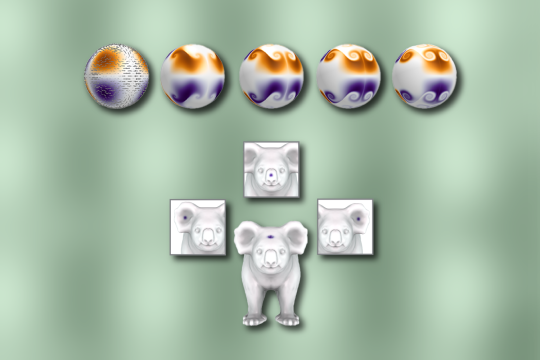

Computer graphics and geometry processing research provide the tools needed to simulate physical phenomena like fire and flames, aiding the creation of visual effects in video games and movies as well as the fabrication of complex geometric shapes using tools like 3D printing.
Under the hood, mathematical problems called partial differential equations (PDEs) model these natural processes. Among the many PDEs used in physics and computer graphics, a class called second-order parabolic PDEs explain how phenomena can become smooth over time. The most famous example in this class is the heat equation, which predicts how heat diffuses along a surface or in a volume over time.
Researchers in geometry processing have designed numerous algorithms to solve these problems on curved surfaces, but their methods often apply only to linear problems or to a single PDE. A more general approach by researchers from MIT’s Computer Science and Artificial Intelligence Laboratory (CSAIL) tackles a general class of these potentially nonlinear problems.
In a paper recently published in the Transactions on Graphics journal and presented at the SIGGRAPH conference, they describe an algorithm that solves different nonlinear parabolic PDEs on triangle meshes by splitting them into three simpler equations that can be solved with techniques graphics researchers already have in their software toolkit. This framework can help better analyze shapes and model complex dynamical processes.
“We provide a recipe: If you want to numerically solve a second-order parabolic PDE, you can follow a set of three steps,” says lead author Leticia Mattos Da Silva SM ’23, an MIT PhD student in electrical engineering and computer science (EECS) and CSAIL affiliate. “For each of the steps in this approach, you’re solving a simpler problem using simpler tools from geometry processing, but at the end, you get a solution to the more challenging second-order parabolic PDE.”
To accomplish this, Da Silva and her coauthors used Strang splitting, a technique that allows geometry processing researchers to break the PDE down into problems they know how to solve efficiently.
First, their algorithm advances a solution forward in time by solving the heat equation (also called the “diffusion equation”), which models how heat from a source spreads over a shape. Picture using a blow torch to warm up a metal plate — this equation describes how heat from that spot would diffuse over it.
This step can be completed easily with linear algebra.
Now, imagine that the parabolic PDE has additional nonlinear behaviors that are not described by the spread of heat. This is where the second step of the algorithm comes in: it accounts for the nonlinear piece by solving a Hamilton-Jacobi (HJ) equation, a first-order nonlinear PDE.
While generic HJ equations can be hard to solve, Mattos Da Silva and coauthors prove that their splitting method applied to many important PDEs yields an HJ equation that can be solved via convex optimization algorithms. Convex optimization is a standard tool for which researchers in geometry processing already have efficient and reliable software. In the final step, the algorithm advances a solution forward in time using the heat equation again to advance the more complex second-order parabolic PDE forward in time.
Among other applications, the framework could help simulate fire and flames more efficiently. “There’s a huge pipeline that creates a video with flames being simulated, but at the heart of it is a PDE solver,” says Mattos Da Silva. For these pipelines, an essential step is solving the G-equation, a nonlinear parabolic PDE that models the front propagation of the flame and can be solved using the researchers’ framework.
The team’s algorithm can also solve the diffusion equation in the logarithmic domain, where it becomes nonlinear. Senior author Justin Solomon, associate professor of EECS and leader of the CSAIL Geometric Data Processing Group, previously developed a state-of-the-art technique for optimal transport that requires taking the logarithm of the result of heat diffusion. Mattos Da Silva’s framework provided more reliable computations by doing diffusion directly in the logarithmic domain. This enabled a more stable way to, for example, find a geometric notion of average among distributions on surface meshes like a model of a koala.
Even though their framework focuses on general, nonlinear problems, it can also be used to solve linear PDE. For instance, the method solves the Fokker-Planck equation, where heat diffuses in a linear way, but there are additional terms that drift in the same direction heat is spreading. In a straightforward application, the approach modeled how swirls would evolve over the surface of a triangulated sphere. The result resembles purple-and-brown latte art.
The researchers note that this project is a starting point for tackling the nonlinearity in other PDEs that appear in graphics and geometry processing head-on. For example, they focused on static surfaces but would like to apply their work to moving ones, too. Moreover, their framework solves problems involving a single parabolic PDE, but the team would also like to tackle problems involving coupled parabolic PDE. These types of problems arise in biology and chemistry, where the equation describing the evolution of each agent in a mixture, for example, is linked to the others’ equations.
Mattos Da Silva and Solomon wrote the paper with Oded Stein, assistant professor at the University of Southern California’s Viterbi School of Engineering. Their work was supported, in part, by an MIT Schwarzman College of Computing Fellowship funded by Google, a MathWorks Fellowship, the Swiss National Science Foundation, the U.S. Army Research Office, the U.S. Air Force Office of Scientific Research, the U.S. National Science Foundation, MIT-IBM Watson AI Lab, the Toyota-CSAIL Joint Research Center, Adobe Systems, and Google Research.
#3d#3D printing#Accounts#adobe#affiliate#agent#ai#air#air force#algorithm#Algorithms#applications#approach#Art#artificial#Artificial Intelligence#author#Biology#california#chemistry#college#computer#Computer Science#Computer Science and Artificial Intelligence Laboratory (CSAIL)#Computer science and technology#computer-graphics#computing#conference#data#data processing
0 notes
Link
Forecasting multivariate time series is a cornerstone for countless applications, ranging from weather prediction to energy consumption management in today’s data-driven world. While effective to a degree, the traditional models often need help to f #AI #ML #Automation
0 notes
Text
Conservative finite volume scheme for first-order viscous relativistic hydrodynamics. (arXiv:2201.12317v3 [gr-qc] UPDATED)
We present the first conservative finite volume numerical scheme for the causal, stable relativistic Navier-Stokes equations developed by Bemfica, Disconzi, Noronha, and Kovtun (BDNK). BDNK theory has arisen very recently as a promising means of incorporating entropy-generating effects (viscosity, heat conduction) into relativistic fluid models, appearing as a possible alternative to the so-called M\"uller-Israel-Stewart (MIS) theory successfully used to model quark-gluon plasma. The major difference between the two lies in the structure of the system of PDEs: BDNK theory only has a set of conservation laws, whereas MIS also includes a set of evolution equations for its dissipative degrees of freedom. The simpler structure of the BDNK PDEs in this respect allows for rigorous proofs of stability, causality, and hyperbolicity in full generality which have as yet been impossible for MIS. To capitalize on these advantages, we present the first fully conservative multi-dimensional fluid solver for the BDNK equations suitable for physical applications. The scheme includes a flux-conservative discretization, non-oscillatory reconstruction, and a central-upwind numerical flux, and is designed to smoothly transition to a high-resolution shock-capturing perfect fluid solver in the inviscid limit. We assess the robustness of our new method in a series of flat-spacetime tests for a conformal fluid, and provide a detailed comparison with previous approaches of Pandya & Pretorius (2021).
from astro-ph.HE updates on arXiv.org https://ift.tt/lC6A2QH
0 notes
Quote
In October 2019, Karniadakis and his colleagues came up with what they call DeepONet: a deep neural network architecture that can learn such an operator. It’s based on work from 1995, when researchers showed that a shallow network can approximate an operator. Because a neural network is involved, such operators are called neural operators, approximations of the actual operators. “We extended the theorem to deep neural networks,” Karniadakis said. What makes DeepONet special is its bifurcated architecture, which processes data in two parallel networks, a “branch” and a “trunk.” The former learns to approximate a number of functions on the input side, and the latter does the same for functions on the output side. DeepONet then combines the outputs of the two networks to learn a PDE’s desired operator. Training DeepONet involves repeatedly showing it the input-output data for a family of PDEs, generated using a numerical solver, and adjusting the weights in the branch and trunk networks in each iteration, until the entire network is making acceptably few errors.
New Neural Networks Solve Hardest Equations Faster Than Ever | Quanta Magazine
0 notes
Photo

Wolfram Models as Discretization Methods for Numerical PDE Solver [WSS 2020]
Yanal Marji
0 notes
Text
破解卡脖子新思路 CCF容錯大會發布OpenBELT開源EDA倡議
本次大會主題是“容錯護航硬科技發展”,就芯片、軟件、系統等領域的硬科技技術進行了廣泛、深入的學術交流,吸引了來自學術界和工業界500餘人參加了本次大會。在本次大會上,討論了諸多集成電��領域的熱門話題,像芯片安全、開源EDA和開源IP、存儲容錯和存儲計算等,最為有興趣的是北京大學羅國傑博士介紹的關於開源EDA方面的工作。
在8月14日的大會特邀報告上,宣布了由國內自主發起的一個開源EDA框架——OpenBelt倡議,倡議者、北京大學高能效計算與應用中心(CEDA)的羅國傑副教授在大會的特邀報告中詳細介紹了OpenBelt的設計動機和思路。 OpenBelt是由北京大學、中科院計算所、清華大學、復旦大學等EDA領域研究優勢單位合作發起的一個開源EDA框架,目的是通過聯合國內在EDA領域的學術界和工業界力量,構建自主、創新、滿足後摩爾時代芯片設計的新型設計方法學生態和社區。
OpenBelt開源EDA框架
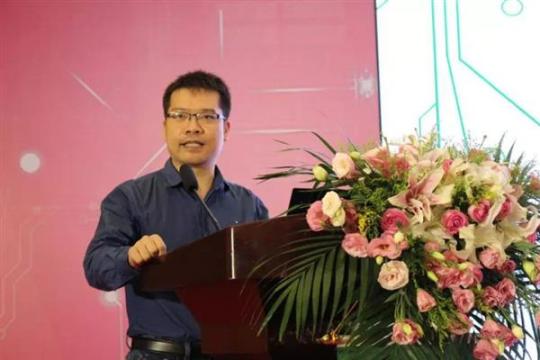
羅國傑博士“OpenBELT: 開源 EDA 端到端框架的設想”大會報告
羅博士的大會報告首先從開發技術領先、成熟EDA需要的人才開始。參考EDA巨頭的研發投入,Synopsys和Cadence兩家公司在2018年度的研發費用均已達60至70多億人民幣,每年至少需要3000名研發工程師才能達到和巨頭們類似的創新研發能力。然而,目前國內EDA領域的人才培養還相當滯後,數量嚴重不足。羅博士在報告中做了初步估算: 假設國內學生在EDA領域頂級期刊IEEE TCAD的投稿中佔比六分之一,也就是每年約30篇,再假設博士生在校時每五年需要發3篇論文,則估算出國內EDA領域的在校博士生���有約50名。這和人力需求相比,還有很大的差距。一方面,如何高效培養EDA領域人才來彌補這一巨大的差距是一個亟待解決的問題。同時,也說明我們要在現有技術基礎上,開發和當前領先的EDA工具相似水平的工具,首先要解決人才儲備不足的問題。

圖: Cadence和Synopsys的年度研發費用(CDNS: Cadence,SNPS: Synopsys)
參考互聯網和人工智能領域近年的進展,開源技術及社區促進了開發人員和領域技術的快速增長。現在最流行的深度學習庫,很多都實現了開源。通用開發者社區Stack Overflow,GitHub提供了非常多的代碼以及問題解決方案,非正式的技術討論平台arxiv和quora也會分享一些初步研究成果和觀點。開源技術和社區降低了領域的門檻,使得更多領域外的研究者可以接觸到更前沿、更具體的問題及其解決方案,也可以做出一定貢獻,推動領域的發展。
羅博士的報告接著分析了設計開源端到端EDA工具鏈的重要意義。 EDA開發者教育和培訓的規模化、以開放的社區消除專業技術交流壁壘、以端到端的開源工具鏈吸納社會資源,其中通過定制芯片開發來吸收自然科學和工程探索領域的部分政府經費、通過便利技術需求的表達與技術成果的評測交付來吸收校企合作經費、以降低小團隊獨立創業和生存的難度來吸收風險投資。
當然,與傳統軟件不同,開源EDA有其自身的難度。 EDA 技能跨越算法層面和物理層面涉及眾多複雜專業知識、開發完整的EDA工具鏈需要眾多社區開發者的支持與維護、以及運行大規模設計的EDA工具的需要大量的高性能服務器。
在整個EDA領域的開發過程中,軟件複雜度問題可以通過智能、層次化和功能重用解決。一套完整的EDA開發流程往往可以分為以下幾個層次: 具體點工具(如ExtTool、STA、P&R、synthesis等)、專用求解器(如DAE solvers、PDE solvers、Machine learning、Compilers等)、通用求解器(如Nonlinear solvers、Fast linear solvers、Discrete optimization等)、以及數學模型(連續數學和離散數學)。如果能夠通過層次化和功能重用搭建起一套高質量全流程的開源EDA算法框架,便可以針對ASIC流程、FPGA流程、定制體系結構流程、類腦芯片流程等諸多目標,在芯片設計者、EDA算法開發者、框架開發者間建立起一套能夠快速迭代、分工明確的合作體系,合力解決複雜而繁瑣的EDA問題。
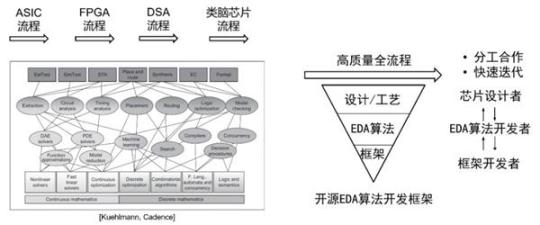
圖: 開源EDA算法開發框架
目前國外已經提出了一些開源EDA的框架與項目。其中,IEEE CEDA提出了DATC項目,將學術界舉辦的設計自動化比賽中的單點工具,根據一定的設計標準格式,整理出一套開源EDA流程; 由美國國防高級研究計劃局DARPA資助的OpenROAD項目,通過開源EDA工具研究與開發,以實現電子設備智能設計IDEA計劃的目標,即24小時內無人參與完成芯片設計。同時,DARPA電子復興計劃的一系列與開源硬件和EDA相關的計劃,如開源硬件項目POSH、IP重用項目CHIPS、領域專用芯片項目DSSOC、以及軟件定義硬件項目SDH等也與設計方法學創新密切相關。
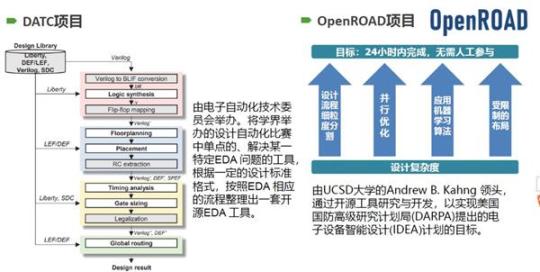
圖: 國外的開源EDA項目
為了吸引更多的開發者加入EDA領域,EDA需要和其它新興領域相結合,這主要包括三個方面。一是和EDA領域的上游相結合,近年來新興器件帶來了許多特殊的EDA需求,如存內計算、量子計算等,傳統的EDA流程不再適用,這就需要開發者們針對它們設計新的流程。二是和EDA領域的下游相結合,近年來有許多新興應用,如物聯網、5G、AR/VR等,對性能和功耗有了更高的要求,通用的EDA流程無法滿足,開發者們需要針對應用設計新的流程; 此外,EDA的設計過程和設計目標也需要根據新興算法作出調整,機器學習算法就是一個很好的例子。三是和EDA自身發展相結合,新興的設計方法學,如敏捷開發,會幫助改進EDA領域開流程。
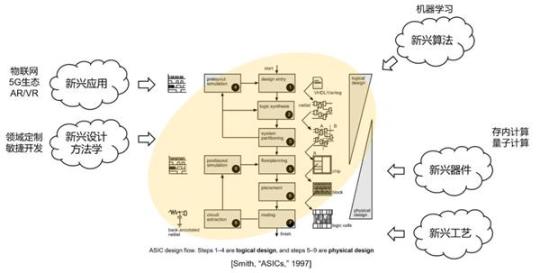
圖: 開源EDA的新需求
羅博士最後表達了OpenBelt作為公共領域設想而不是具體項目,需要凝聚學界和業界的廣泛力量來解決的問題。期望框架能高效實現的算法和代碼重用、點工具與流程的版本管理、分佈式和雲平台支持等功能。目前,北京大學高能效計算與應用中心正在開展OpenBelt初步框架的搭建工作。
為了更進一步深入探討開源EDA和開源IP的相關技術,CCF容錯大會在16號和17號兩天下午,分別組織了專題論壇,邀請了眾多學者和業界嘉賓從AI EDA和開源IP等不同角度深入探討開源EDA的可行性和具體技術路線,嘉賓和觀眾一直認為開源EDA可以降低EDA領域門檻,可以讓學界減少重複性工作,對學術界甚至整個EDA領域發展非常有好處,但是如何激勵和推行開源工作仍需要有深入的思路。
CCF容錯專委秘書長、一直從事專用處理器芯片研究工作的中科院計算所韓銀和研究員,也是OpenBelt的倡議者之一,在論壇中表達了OpenBelt應該和敏捷開發相結合的思路。開源首要的是可幫助降低成本,但當前芯片設計而言,設計複雜度和設計週期過長,是更為急迫的剛需。如果說目前這一代的設計方法學(DA)解決了大規模設計的問題,滿足了通用計算芯片設計規模更大、運行頻率更高等需求; 下一代設計方法學可能需要關注快速設計的問題,也即敏捷開發的問題,滿足人機物三元時代專用芯片種類更多、設計週期更短、單片人力投入更少等需求。 OpenBelt框架在設計之初,就可構建在類似Chisel等新的設計語言上,設計開源的中間文件交換格式,這樣就可以很好的整合當前算法界和系統界在圖計算優化方面的最新成果,設計更快、功能更強的仿真、綜合等工具。同時,通過開源,吸引更多人工智能方面的最新研究進展,使得整個EDA框架更加自動化。同時,通過設計復用開源IP,可以大幅加速芯片設計的周期,OpenBelt應融合這方便的優勢。
開源EDA框架要想成功,需要學術界和產業界的共同努力,非常不容易,CCF容錯專委會持續舉行活動,推動國內主導的開源EDA框架的嘗試。
2019 CCF集成電路Early Career Award揭曉,上海交大蔣力副教授獲此殊榮
大會的另一個重頭戲是揭曉今年的CCF 集成電路 Early Career Award。中國計算機學會 CCF 集成電路 Early Career Award 針對工作不超過 6 年的青年學者設立, 為從事集成電路方向的青年學者早期職業生涯提供支持。這是中國計算機學會體系內目前唯一的一個集成電路專業獎項,去年啟動首屆評選,今年已是第二年。
經過7名國際國內同行專家的三輪評審,最終,上海交通大學的蔣力副教授獲得其項殊榮,以表彰他在後摩爾時代集成電路測試容錯設計方面領域所做的學術貢獻。
蔣力副教授一直專注於從事集成電路測試和電路容錯技術研究,他針對三維芯片高成本問題,率先提出三維芯片“綁定前測試”架構設計與優化方法,被引入IEEE 標準P1838。針對 3D IC中TSV的高故障率,率先設計了極為高效的TSV 修復架構和三維存儲器中相鄰晶片上冗餘資源共享技術,刷新了三維存儲器修復效率的記錄。
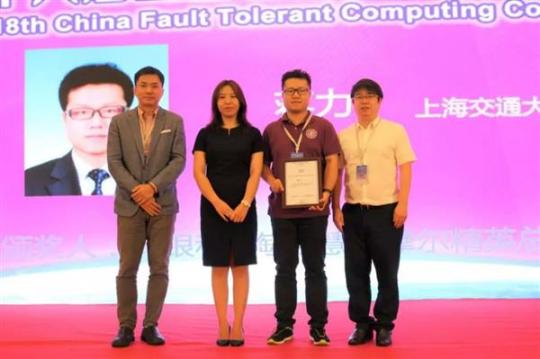
圖: 評獎主席汪玉教授主持蔣力博士的獲獎儀式
摩爾精英公司連續兩年贊助了CCF 集成電路 Early Career Award。人才是半導體產業發展的引擎,摩爾精英董事長兼CEO張競揚表示,能不能持續吸引像蔣力副教授這樣的優秀青年加入行業,並充分實現他們的個人價值,對整個產業來說至關重要。同時,通過一站式芯片服務平台,可以加速研發成果轉化,促進產業發展,這也正是摩爾精英成立四年來所做的探索,為1500家芯片公司提供芯片設計服務、流片封測服務、人才服務和企業孵化服務,同時積極探索SiP, Chiplet和EDA/IP上雲等創新模式,幫助提升芯片創新的啟動率、實現效率和成功率,最終目標是用1/10的資金、1/10的時間和1/10的團隊��完成芯片產品研發,投入市場。摩爾精英的使命是,讓中國沒有難做的芯片,我們正在不斷努力,一步步往這個目標邁進。
訪問:
阿里雲 – 最高1888元通用代金券立即可用
.
from 破解卡脖子新思路 CCF容錯大會發布OpenBELT開源EDA倡議 via KKNEWS
0 notes
Text
Buy Apcalis Jelly will help with Erectile Problem

Apcalis Jelly
The medication Apcalis Oral Jelly contains the substance Tadalafil and has an extremely harmonious impact as the well-known medication Viagra. Thanks to this substance you have no more problems with the annoying erection problems.
Apcalis Jelly keeps up erection during s*x. You ought not to take Apcalis oral jelly on the off chance that you have tanked grape juice. Apcalis oral jelly ought not to be used by women and children. It is the most prominent fluid based generic medicine that people use to treat erectile dysfunction. These mouth gels are available in different flavors.
The Potency delivers well to excellent results and improves erection. When you buy Apcalis, you can benefit from an incredible erection and make it last much longer. This will make your s*x partner glad and safely rid the recently known issues of the world.
In something contrary to Viagra Apcalis Jelly does not show up in tablet form, yet is offered as a gel. This is in the very cheap to arrange in the most incredible flavors on the web. You can take Apcalis totally without water.
Work of Apcalis jelly
This medication works by influencing the working of a specific hormone that happens naturally in the body. This chemical is called PDE-5 and it assumes a significant job in hindering the activity of another hormone called cGMP. The latter is a neurotransmitter that is responsible for increased blood flow to the p***s during s*x, thereby causing an erection. In normal circumstances, PDE-5 kicks in after s*x to allow the blood to leave the genitals. For men experiencing erectile dysfunction, however, a lot of this chemical forestalls a lasting erection inside and out. Apcalis Jellies restore the balance between these two synthetic substances simultaneously as significantly expanding blood stream to the p***s.
Apcalis Jelly Usage Instructions
Take one sachet of Apcalis Jelly at least 15 minutes before you plan to have s*x. You should see effective results within 15-30 minutes of ingestion. Abstain from drinking liquor or devouring any grapefruit or grapefruit side-effects when using this medication as this can adversely lessen its adequacy.
Dosage Recommendations
As referenced over, the prescribed dosage is one sachet taken at any rate 15 to 30 minutes before s*x. Do not take more than one sachet in any 24-hour period and always stick to the recommended dosage as taking more than advised will not yield further benefits and may increase the risk of side effects.
How is Apcalis different from kamagra?
Apcalis jelly is an ED medicine as a smooth pudding-like surface or consistency. An amazingly compelling synthetic compound which contributes toward arousal and incitement, it incorporates the fixing Tadalafil, otherwise called Cialis. This issue solver is sensibly evaluated and quick acting. The outcomes may proceed for up to thirty-six hours, and as it is delicate, it doesn't expect you to need to swallow anything strong.
This is a noteworthy in addition to for some, who experience issues with gulping pills. This type of medication is the least demanding to take, and frequently is bundled in an easy to open packet that just requires a little squeeze. It shows results within fifteen minutes and is easily available. Kamagra, however, requires you to take it an hour in advance of s**ual activity, as it is only within thirty minutes to an hour that it will start to have an effect. It can last for approximately twelve hours and contains the component Sildenafil, which is also known as Viagra.
The both of them guarantee comparable results and cost about the equivalent. Eventually, the decision between the two comes down to individual inclination dependent on to what extent you need it to last, how rapidly you need it to kick in, and your inclination of fixings and strategy for conveyance.
What are some of the benefits?
One of many reviews regarding this product is from Sarah Tedlestone in Norfolk, England, on an open review website. She writes, "I started to worry about my dear husband a few years ago because I noticed that our s**ual life was no longer as passionate as before. He seemed so indifferent to such pleasures, but I didn’t hurry with my conclusions and decided to talk to him. He explained to me that impotence most importantly, this item enables access to the fast transition assortment of Tadalafil to those with an antipathy for or difficulty with taking pills. As referenced, this makes it so a lot handier! It arrives in an assortment of natural product flavors, too, causing the prescription to go down more smoothly. It keeps going longer and produces results more rapidly than elective forms of cures that are made to be expended in a similar way. It's accessible to attempt in 20 mg tests just as the other portion alternatives, so you can attempt to contrast it with other like items before you put any real money in it. was at fault, so I tried to help him by ordering [this], and it really helped us!"
We encourage you to write your own review, once you try this for yourself and see what it can do! The more information that is spread around about it, the better it will be for potential users. On the whole, this is both effective and efficient.
How Does Apcalis Oral Jelly Stand Apart from The Rest?
The title says everything. Apcalis Jelly is semi-liquid type of ED alleviation that enables patients to devour this medicine without the need of a glass of water. While this may at first appear to be a genuinely trifling change to make, it really opens up unmistakably more potential outcomes and advantages that relatively few consider. For example, this coagulated structure factor enables men of a more seasoned age to all the more effectively ingest and devour this medication without having to sit and struggle down a large tablet. Apcalis Jelly also activates much faster as it dissolves into your body at a much more rapid pace, taking only 15 to 30 minutes to start showing results.
Can you buy this product?
Apcalis Oral Jelly, just as an assortment of other erectile dysfunction medications, is accessible through web medicine suppliers. These foundations offer the vastest choice at the best costs. The majority of their items are accessible for minimal expenditure and without a medicine, so you don't need to visit the doctor to get what you need. No specialist's visit, no protection bother, and no trek to the physical store is required for you to get this top-decision issue solver. Their site is past easy to use; before you know it, you'll have found your choice of decision, inputted your information to place the order, and then have it delivered quickly and discreetly, directly to your front door. They pride themselves on their non-specific plain packaging, so your business is safe from the prying eyes of nosy neighbors
Are sites like these really as trustworthy as they claim? Well, we don't want to sell you beachfront property in Arizona - the majority of them are, in fact, not. All the more reason to stick with the ones who are tried and true, wouldn't you say? So give it a shot for yourself, and see what the result is!
You would now be able to get this item and others from the most dependable Canadian drug store online without a solution. They guarantee a simple to utilize site, the least expensive costs, and the best choice. They convey every one of their bundles in circumspect bundling so you can rest guaranteed that your mystery is sheltered from according to meddlesome neighbors. Apcalis Oral Jelly is the best erectile brokenness treatment in this structure accessible available and it's presently accessible at an extremely minimal effort because of this virtual vender. They give 20 mg measurements. You will love picking this brand for your ED treatment and you surely will love requesting it from this business. Go ahead and give it a chance! Why might some want to buy from a virtual vendor? This is especially comprehensible if one resides in the United States of America, where healthcare cost is through the roof! That includes the cost of medicine as well. Obtaining from an online seller is one way that many are turning to try and lower or undercut their cost, and this site will not disappoint in that endeavor. Retain in mind that ordering online can be extremely hazardous, according to the FDA, so always check reviews before you share your information to an unknown third party.
Considerations Before you Buy Apcalis Jelly Online
This product is one of numerous brands that can offer help from erectile dysfunction. Each brand is one of a kind in its concoction make-up, and most brands available today contain one of three dynamic fixings. These center substance mixes are vardenafil, sildenafil citrate and tadalafil. Before you buy Apcalis Jelly online, you should do the research necessary to ensure that tadalafil is safe to consume in your physical condition, as most drugs sold online have certain precautions and contraindications. Failing to adhere to these could result in health complications. You should not buy Apcalis Jelly if you:
Have a curved p***s
Suffer from coronary artery disease or angina
Have stomach ulcers
Have abnormal blood pressure
Have problems with your liver or kidney
Are there any Side Effects?
While it is conceivable that you may encounter some gentle reactions when taking this medicine, extreme symptoms are not usually connected with Apcalis Jellies. Basically, just a little minority may experience the ill effects of reactions, and on the off chance that they do, these are commonly mellow and fleeting. Seriousness of impacts can also be reduced by keeping hydrated, adhering to the recommended dosage and by following the applicable precautions. Side effects when you buy Apcalis Jelly for erectile dysfunction may include:
Nausea
Headache
Upset stomach
Flu-like symptoms
Heartburn
Light-headedness
Blurry vision
Facial flushing
There have been incredibly uncommon cases in the past where men have experienced priapism in the wake of taking Apcalis Oral Jelly. This might be because of other health factors, but if your erection lasts for longer than 4 hours, consult your doctor immediately.
You can now buy your Apcalis online
Appreciate the joys of s*x by and by when you purchase Apcalis jelly online through our regarded and acclaimed online pharmacy.
0 notes
Text
Harmonic Analysis Assignment Homework Help
https://www.statisticshomeworktutors.com/Harmonic-Analysis-Assignment-Homework-Help.php
Best Harmonics homework help department ensures that student’s Harmonics assignments are done accurately and within the set deadline. Harmonic Analysis homework solver also recommends that students undertaking Harmonics assignments should be conversant with Algebra lineaire up to level two and Analyze up to level five. In addition, online Harmonics homework tutors recommend that students should master key concepts related to Harmonics Analysis. These concepts include Lebesgue and, concepts of real Analysis such as measure and lastly, they should be in a position to construct rigorous mathematical argument.
At online Harmonics Analysis assignment experts, we ensure students homework has been completed as desired. In addition, our system supports Harmonics online assignment help which facilitates online tutoring through platforms such as Skype video and hangouts among many other platforms available to students. Harmonic Analysis homework help will ensure students are in a position performs an Analysis of the convergence of Fourier series, do an examination of bounds for singular integrals and prove bounds for dispersive PDE.
#Harmonic Analysis Assignment Homework Help#Harmonic Analysis Assignment Help#Harmonic Analysis Homework Help#Harmonic Analysis Online Help#Harmonic Analysis Project Help#Harmonic Analysis Assignment Homework Help Experts
0 notes
Text
Scalable Solvers for Stochastic PDEs in High-Performance Computing
Abstract: For the scientific applications modeled using partial differential equations (PDEs), it is now common to use millions of spatial discretization for deterministic simulations. Incorporating uncertainty characterized by thousands of stochasti https://www.environmentguru.com/pages/elements/element.aspx?utm_source=dlvr.it&utm_medium=tumblr&id=5850592
0 notes
Text
26 new Companies Join the Vive X Accelerator Programme
In 2016 HTC Vive launched its $100 million USD Vive X accelerator programme with the aim to encourage advancement and innovation in the virtual reality (VR) and augmented reality (AR) industry. There’s already been some notable successes, with TPCAST’s wireless module the most well known from the first batch of start-ups. Today, Vive X has announced its third batch of start-up companies to join its ranks, alongside expanding operations into a fifth location,Tel Aviv.
Twenty-six new companies across the world have been selected to participate, all with the goal of building and advancing the global VR/AR ecosystem. Through the Vive X programme they’ll get access to expertise, resources, planning and an extensive network to help nurture their projects and bring them to market.
“Our focus with Vive X is to partner with companies across the globe that will solve industry pain-points and improve user experiences across AR and VR. This third batch is filled with incredibly talented and promising teams who are focusing on foundational technologies and key verticals including enterprise, healthcare, entertainment, and education,” said Marc Metis, Vice President, HTC Vive in a statement. “We continue to invest very actively in both VR and AR, and are excited to work with the next group of innovative teams and technologies that will shape the future.”
The companies included in Vive X Batch 3 are:
San Francisco
Apelab seeks to democratize content creation for VR/AR. Its software toolkit Spatial Stories allows developers, designers or anyone without coding knowledge to build fully interactive XR content quickly and efficiently within an immersive environment, then export it to various platforms.
CALA offers a full-stack software solution that empowers fashion designers to turn ideas into garments faster – from first sketch to production and everything in between. Its 3D scanning technology allows consumers to easily take body measurements with smartphone photos and AR technology, then receive their orders with perfect fit.
Cloudgate Studio is an acclaimed game development studio behind hit VR titles Brookhaven Experiment and Island 359. A brilliant team of industry veterans, Cloudgate is on a strategic path to build game tech modules that will culminate in the first hit title for VR eSports. Virtual Self as an example allows users to see their body in VR and stream their gameplay without expensive setups.
eLoupes provides a real-time surgical imaging system for the operating room. Combining light field rendering and head mounted displays, hospitals can bring surgeons a solution that is superior to traditional imaging systems like microscopes while saving costs and improving patient outcomes.
Nanome seeks to democratize science and engineering using VR and Blockchain technology. Today’s legacy systems are outdated and create enormous inefficiency in the innovation process. With an intuitive and distributed platform to interact with scientific data, Nanome will help accelerate scientific innovation like never before.
Neurable develops brain-computer interface for VR control. The result of innovations in neuroscience and machine learning, Neurable interprets electroencephalography (EEG) signals for real-time interaction input. Think, “mind-controlled” experiences.
Quantum Capture is building the behavioral engine that will power the world’s AI-assisted virtual agents. Combining photo-real 3D characters, procedural animation systems and support for cognitive AI, Quantum Capture aims to equip developers with the necessary tools to create amazing, virtual human- based applications, while substantially reducing costs and compressing production timelines.
QuarkVR is the next-generation compression and streaming technology for untethered VR and AR experiences. It is a hardware agnostic software solution that supports 4K per eye resolution and is capable of streaming to a dozen simultaneous users in the same environment with minimal latency.
Beijing
Future Tech is a Chengdu, China- based studio that creates quality games and VR content for users around the world. The team is founded by industry veterans with deep experience from global content powerhouses like Ubisoft, Gameloft, PDE, and Virtuos. Their current project “Mars Alive” has won numerous industry awards globally.
Genhaosan (GHS) is the first-ever available VR entertainment solution for karaoke. The GHS VRK systems installed in karaoke rooms allow users to enjoy immersive experiences like singing like a rock star on stage, interacting with their audience and sharing their performance on social media.
JuDaoEdu is dedicated to the research and development of VR labs for K-12 students. The product is applicable for Physics, Chemistry, Biology and Science education and the company’s vision is to provide students with authentic and safe VR lab environment.
Lenqiy is a leading VR content developer providing innovation and creativity education to teenagers. Their current product portfolio includes science, engineering, technology, art and mathematics VR tools. By bringing creativity into product design, Lenqiy wants to make learning an enjoyable journey of exploration for teenagers.
PanguVR is an AI-driven VR technology company with a focus on advanced computer vision. Its core engine, powered and refined by deep learning and processing thousands of terabytes of data, allows users to create 6DoF VR environments in minutes simply by uploading 3D assets or even 2D pictures. The process is fast and produces stunning quality output at only a fraction of the cost associated with manual process.
Pillow’s Willow VR Studios creates fairytale games for both 3DoF and 6DoF VR, excelling with its high-quality visuals while maintaining maximum performance. Their non-violent casual VR games featuring curious, likeable characters, are fun, easy to play and suitable for all ages.
Yue Cheng Tech aims to become the Netflix in VR. The company has selected more than 300 top-quality VR contents from 50+ partners in 15 countries, introduced them to China, and created world’s first professional VR cinema. YCT also produce world-class contents with the world’s top talents in visual effects and movie industry.
Shenzhen
Antilatency specializes in positional tracking solutions for VR/AR that enable multiplayer VR experiences within the tracking area without scale limits, using mobile or tethered VR headsets.
Configreality understands deeply how human spatial perception works across physical and virtual space simultaneously. With its proprietary spatial compression algorithm, users can feel as if they are walking in an infinitely large space even when the physical space is limited.
Super Node is a visual intelligence company with full-stack solutions that enables machines to learn its surrounding environments. The solution brings low-cost, high-accuracy obstacle avoidance, 6DoF tracking and SLAM (Simultaneous Localization and Mapping) capabilities to VR, AR and robotics.
VRWaibao offers a multiplayer collaboration platform in VR, while also creating a wide range of enterprise VR applications for customers in banking, manufacturing, real estate, healthcare, military and more.
Wewod is focused on delivering high-quality, location-based entertainment and educational VR content. The team has deep experience delivering 3D production work for renowned clients like Disney, Bandai Namco, and Nintendo.
Taipei
COVER provides a virtual livestreaming platform which users can perform with their avatars for audience to watch via mobile devices. It also offers live shows featuring their own virtual celebrities.
Looxid Labs has developed an emotional analytics platform optimized for VR using bio-sensors that measure users’ eyes and brain activities. Its machine learning algorithm is capable of accurately analyzing users’ emotional state, providing valuable data that can be leveraged to make a real impact in users’ VR experiences.
Red Pill Lab applies deep learning algorithms to optimize the workflow of real- time character animation. Its voice-to-facial engine and full body IK-solver work together to add a new level of realism to virtual characters in VR games.
VRCollab takes BIM (Building Information Modelling) to the next level, enabling architects, engineers, planners and consultants to collaborate seamlessly on construction projects. It is a software solution that instantly converts BIM models for use in design reviews, building requirement approval and construction coordination, as well as automated document generation.
Tel Aviv
Astral Vision turns existing amusement park rides into VR attractions, offering a compelling and refreshing customer experience without engaging in capital-intensive upgrades.
REMMERSIVE is founded by award-winning technologists and race driving champions, and creates a new breed of fully immersive driving simulators with technology, providing a far more engaging and true-to-life experience.
VRFocus will continue its coverage of Vive X, reporting back with the latest updates.
from VRFocus http://ift.tt/2ilO7rA
0 notes
Text
Computational finance Assignment Help
Computational finance is a branch of applied computer science that deals with problems of practical interest in finance.Following is the list of topics in Computational finance in which our experts provide help with:
Advanced financial data analysis
Asset pricing and inefficiency of markets
Black-Scholes equation and PDEs
Crank-Nicolson finite difference methods
Estimating Greek letters and Value at Risk
Euler’s theorem, asset contributions to volatility
Explicit finite difference method
Fourier analysis: discrete Fourier transforms
Generating random numbers and Monte-Carlo simulations
Implicit finite difference method
Markowitz Algorithm using the solver and matrix algebra
Master of Computational Finance
Numerical solution of system of nonlinear equations
Portfolio theory with matrix algebra
Quasi Monte-Carlo simulations
Review of unconstrained optimization methods
Statistical Analysis of Efficient Portfolios
The constant expected return model
Univariate random variables and distributions
0 notes
Text
dNNsolve: an efficient NN-based PDE solver. (arXiv:2103.08662v1 [cs.LG])
Neural Networks (NNs) can be used to solve Ordinary and Partial Differential Equations (ODEs and PDEs) by redefining the question as an optimization problem. The objective function to be optimized is the sum of the squares of the PDE to be solved and of the initial/boundary conditions. A feed forward NN is trained to minimise this loss function evaluated on a set of collocation points sampled from the domain where the problem is defined. A compact and smooth solution, that only depends on the weights of the trained NN, is then obtained. This approach is often referred to as PINN, from Physics Informed Neural Network~\cite{raissi2017physics_1, raissi2017physics_2}. Despite the success of the PINN approach in solving various classes of PDEs, an implementation of this idea that is capable of solving a large class of ODEs and PDEs with good accuracy and without the need to finely tune the hyperparameters of the network, is not available yet. In this paper, we introduce a new implementation of this concept - called dNNsolve - that makes use of dual Neural Networks to solve ODEs/PDEs. These include: i) sine and sigmoidal activation functions, that provide a more efficient basis to capture both secular and periodic patterns in the solutions; ii) a newly designed architecture, that makes it easy for the the NN to approximate the solution using the basis functions mentioned above. We show that dNNsolve is capable of solving a broad range of ODEs/PDEs in 1, 2 and 3 spacetime dimensions, without the need of hyperparameter fine-tuning.
from gr-qc updates on arXiv.org https://ift.tt/313HeOp
0 notes